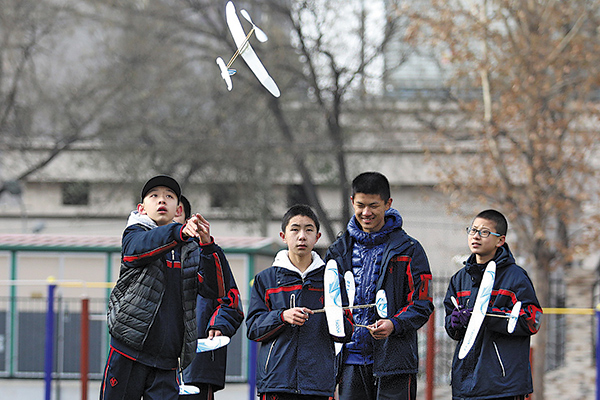
Students fly model airplanes during a science fair in Shijiazhuang, Hebei province, looking for ways to extend flight time.[Photo/Xinhua]
China aims to achieve education modernization by 2035, with easy access to quality education from kindergarten to university.
Two development plans were issued on Feb 23 by the Central Committee of the Communist Party of China and the State Council. One set goals and tasks for 2035, while the other reviewed the education modernization drive from 2018 to 2022.
Eight goals were proposed in the education modernization plan for 2035, which also highlighted vocational training and special schooling for the disabled. It listed 10 strategic tasks, including ensuring equal access to basic public education, building world-class universities and opening education further to the world.
Under the opening-up item are detailed objectives such as promoting the mutual recognition of degrees and diplomas, as well as education cooperation under the Belt and Road Initiative.
The five-year implementation plan covering the 2018-22 period, which was released by the general offices of the CPC Central Committee and the State Council, specified 10 key tasks in advancing education modernization, including requirements on the enhanced use of information technology.
The year 2035 is of special importance in China’s overall development timetable, as the country has pledged to basically realize socialist modernization by then.
At the 19th CPC National Congress in October 2017, the Party identified strengthening education as fundamental to the pursuit of national rejuvenation and promised to give priority to education and promoting educational reform, to speed up modernization and to develop educational models that people are satisfied with.
The 2035 plan also showed China’s active participation in global educational governance, fulfillment of its commitment under the United Nations 2030 sustainable development agenda and its contribution of Chinese wisdom, Chinese experience and a Chinese approach to world educational development, an Education Ministry official said.
Xiong Bingqi, deputy head of the 21st Century Education Research Institute in Beijing, said that to achieve the education modernization plan by 2035, the country needs to continue to increase its spending on education, which has been about 4 percent of GDP since 2012.
Education has been among the issues receiving the most attention from the public, he said, and problems — including educational imbalances between urban and rural students, the heavy academic workload faced by students, and academic corruption and misconduct — have been the subject of widespread public criticism.
Chu Zhaohui, a senior researcher at the National Institute of Education Sciences, said education reform has made remarkable progress since the CPC’s 18th National Congress in 2012, in line with the goal of establishing a modern education system.
“The country has made big achievements in delegating the central authority’s power to local authorities and schools and expanding schools’ right to function independently,” he said. “Yet some reforms remain difficult to implement, such as the canceling of schools’ administrative rankings.”
